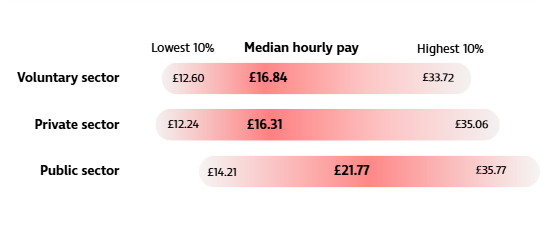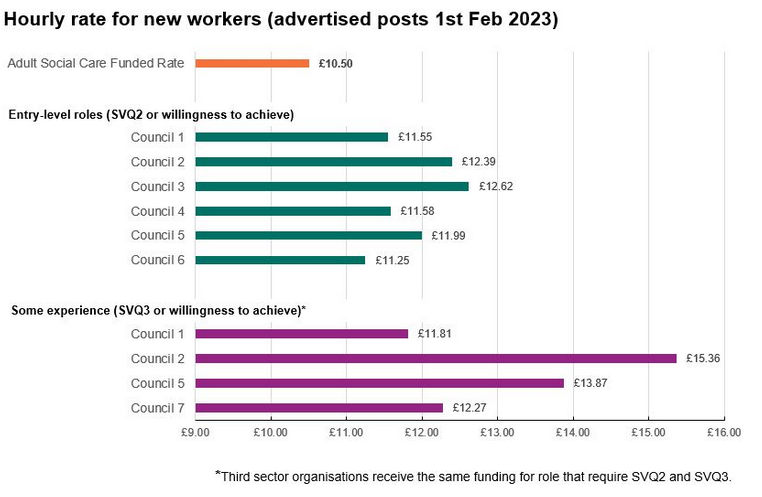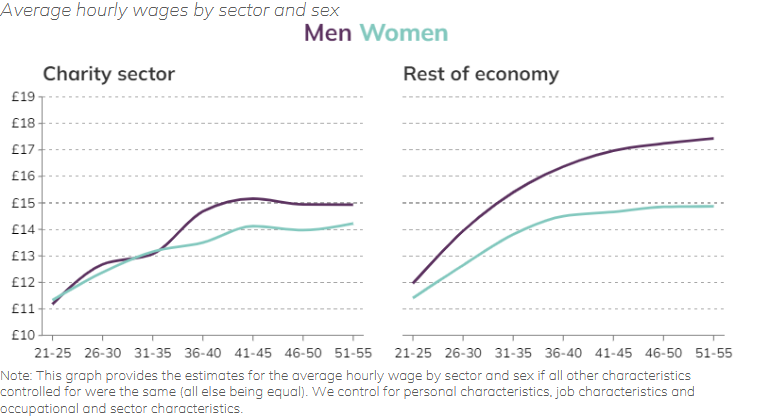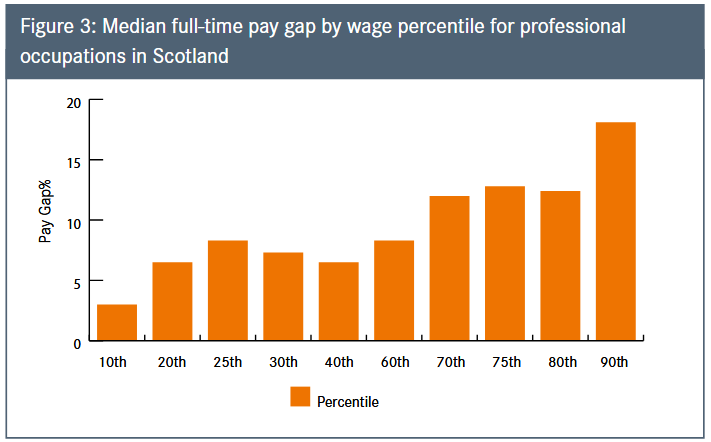Pay in the voluntary sector 2025
An overview of pay and recent pay trends in the voluntary sector
Summary
This report pulls together data on sector pay, comparing salary data from the voluntary sector and the public and private sectors, as well as variations in pay depending on factors such as age, gender and full-time /part-time workers.
The main source of pay data used is the Annual Survey of Hours and Earnings (ASHE) published by the Office for National Statistics (ONS). We also bring in data from sources such as the Living Wage Foundation, the Scottish Third Sector Tracker, and the Goodmoves Salary Guide.
The sector’s 136,000 paid employees are key to the successful delivery of many charities’ activities. Pay is not the only tool that the voluntary sector can use to attract and retain staff, but fair wages that people can live on and pay that can compete with other sectors are essential for a stable and committed workforce. Many voluntary sector organisations currently report recruitment challenges, with many reporting that vacancies are hard to fill due to competition from other service providers and pay-related challenges (see for example The ALLIANCE, 2023, SCVO Tracker, 2024 and Care Inspectorate and the Scottish Social Services Council, 2025).
Key findings
- Across most pay indicators the voluntary sector pays roughly on par with the private sector, but substantially less on average than the public sector.
- The pay gap between the voluntary sector and the wider economy increases with age and through career progression.
- We also find evidence of pay gaps within the sector, in particular a significant gender pay gap, and closely linked to this a gap between pay rates for full-time and part-time workers.
The findings highlight the need for funding to cover fair pay and to be uplifted in line with inflation, and for the sector to improve flexible working practices and address potential areas of pay inequality.
Typical pay and the voluntary sector pay gap
- The voluntary sector pays slightly less compared to the other sectors in Scotland when we look at weekly and annual pay indicators.
- When we look at hourly rates the voluntary sector pays slightly better than the private sector, particularly for those on lower and midpoint wages.
- There is however a large 23% voluntary sector pay gap between voluntary and public sector hourly pay rates.
- In 2025 median hourly pay in the voluntary sector was £4.93 per hour lower than the public sector (£16.84 versus £21.77) - this gap has grown since 2024 when the voluntary sector was £3.88 lower than the public sector.
- In other words, for every £1 a typical public sector employee earned in 2025, a typical voluntary sector worker earned only 77p.
- The voluntary sector pay gap is growing: The gap between voluntary sector pay and pay in the rest of the economy (i.e. public and private sectors) has widened after 2018, driven primarily by public sector pay increases.
- Voluntary sector pay keeps pace with inflation, but only just… sector-wide pay rises have roughly tracked inflation, but both private and public sector workers have seen above-inflation increases in recent years. Many Third Sector Tracker respondents report using reserves etc to subsidise pay and offer staff pay increases in line with or close to inflation.
The part-time penalty, age, and the gender pay gap
- The part-time penalty: part-time workers tend to be paid substantially less than those in full-time roles.
- The Gender Pay Gap: despite a predominantly female workforce, the voluntary sector’s gender pay gap is significant — 14% for hourly pay in 2025. This is notably higher than in the public sector and growing again after a period of narrowing.
- The gender pay gap is most pronounced among full-time workers. Part-time women in the voluntary sector actually earned slightly more than part-time men in 2025 (although as highlighted above both are typically paid less than full-time employees).
- The caring responsibilities penalty:Pro Bono Economics research suggests that women’s pay progression is negatively influenced by childcare etc., leading to more part-time working and a knock-on wage stagnation effect.
- The age /career progression penalty: Pro Bono Economics found that the voluntary pay gap widens as people progress through their voluntary sector careers.
Perceptions of Pay
- Nearly a third of workers in the sector feel underpaid, and women are especially likely to feel underpaid.
The primary data source used in this briefing is the Annual Survey of Hours and Earnings (ASHE) published by the Office for National Statistics (ONS).
ASHE is the main source of earnings data in the UK. It is based on a 1% sample of employee jobs taken from HM Revenue and Customs’ (HMRC’s) Pay As You Earn (PAYE) records.
The ASHE data does not allow us to compare like-for-like salaries for different roles but gives us a good overview of typical pay rates across the different sectors of the economy, as well as comparisons for men and women and for full-time and part-time workers.
The ASHE data has been split into Public, Private and ‘Non-profit body or mutual association’ sectors. The ASHE data uses the term ‘Non-profit body or mutual association’ - this definition is wider than the voluntary sector and covers 219,000 employees, higher than the estimated 136,000 sector employees. The ASHE non-profit data includes organisations such as universities which may offer pay rates higher than voluntary sector bodies and skew the figures. However, this means that any pay gaps seen between the voluntary sector and the other sectors are not only present, but if anything are likely to be an underestimate. Further, the ASHE annual non-profit salary figures are reasonably close to those we see when we look at Goodmoves voluntary sector jobs data. We therefore believe that the ASHE figures can give us meaningful comparisons between the non-profit sectors and the public and private sectors. For this report we have therefore equated the ASHE non-profit data with ‘voluntary sector’ data.
We follow ONS convention and primarily use median salary data in the report, as mean salary data can be skewed by very high salaries: “by taking the middle value of the data after sorting in ascending order, the median avoids this issue and is consequently considered a better indicator of “typical” average earnings.” (ONS, 2017)
Other data sources:
- Goodmoves Salary Guide, 2024 - analysis of over 6,000 charity jobs advertised on Goodmoves. Detailed salary breakdowns are available to all SCVO members.
- Scottish Third Sector Tracker – SCVO-led survey of a representative sample of hundreds of third sector organisations
- SCVO Sector Stats - People
- Living Wage Foundation
- Pay in the Scottish voluntary sector is lower than in the public and private sectors for weekly and annual pay indicators.
- However, annual pay data is influenced by hours worked, which makes comparisons less robust.
According to the Annual Survey of Hours and Earnings (ASHE) the mid-point (median) annual pay in the voluntary sector is £28,781, significantly below both the Private and Public sectors. Average (mean) annual pay in the voluntary sector according to ASHE data is £31,881, also substantially lower than the other two sectors. The ASHE voluntary sector figures are just slightly higher than the median and mean figures we saw when we analyzed Goodmoves voluntary sector jobs data.
-
Weekly and monthly pay in the voluntary sector follows a similar pattern and is also substantially lower than in the public and private sectors. The voluntary sector’s median Annual pay rate consistently tracks well below the public sector and slightly below the private sector – see chart below. The gap between the sectors also appears to have widened slightly in recent years.
-
Salary comparisons
The trends we see in the ASHE data reflect what we see when we compare typical salaries from different job sites. For example, the table below compares typical salaries from a range of jobs advertised on the Indeed Jobs site and the Goodmoves Salary Guide, 2024. It suggests that salaries in the voluntary sector are lower across all role levels. However, note that the following is just a general picture based on a sample of recently advertised jobs on Indeed Jobs, and comes with the caveat that it is very hard to accurately compare like-for-like jobs across the sectors base on job titles alone.
-
While annual pay data can give us some useful insights, it is difficult to accurately compare like-for-like roles on job websites, and the ASHE annual pay data above includes data on part-time salaries which can skew the figures due to the high level of part-time working in the voluntary sector.
For more accurate cross-sector comparisons we therefore focus on hourly pay rates for the rest of this briefing.
For the most accurate comparisons of like-for-like pay between sectors we looked at the ASHE hourly pay data. The ASHE hourly pay data is calculated from weekly and annual pay data divided by actual hours worked.
The median (i.e. mid-point) hourly rate of pay for the voluntary sector in 2025 was £16.84, 53p higher than the Private sector rate of £16.31.
It is however now nearly £5 per hour lower (£4.93) than the median Public sector rate of £21.77 - a increase from 2024 when the voluntary sector was only £3.88 lower than the public sector.
The average (mean) hourly rate of pay in the voluntary sector in 2025 was £20.85, so below the Private sector (£21.56) and £4 lower than the Public sector (£24.85).
Mean hourly pay rates tend to be higher due to the skewing influence that high earners can have on averages. For the rest of this report, we therefore follow ONS practice and use median pay data.
-
In the chart below we can see this is not a new trend. Voluntary sector median hourly pay consistently tracks just above the private sector, but well below the public sector (ASHE 2025).
Median voluntary sector hourly pay increased by only 16p between 2024 and 2025 meaning that the private sector has now closed the gap, while the public sector hourly pay gap has widened even further.
- The voluntary sector has the narrowest gap between the lowest and highest paid staff.

The voluntary sector’s lowest earners are paid less than low earners in the public sector, but slightly better than the private sector’s lowest earners. This ties in with the lower levels of employees paid the Real Living Wage in the private sector, with more private sector workers paid closer to the National Living Wage rate of £11.44 per hour (see Living Wage section below). Median hourly pay in the voluntary sector is also slightly higher than the private sector, but substantially lower than the public sector.
The lowest 10% of earners in the voluntary sector were paid £12.60 per hour or less in 2025 while the 10% highest earners (90th percentile) were paid at £33.72 per hour or higher.
The highest paid 10% in the voluntary sector earn less per hour than those in both the private and public sectors.
The ASHE breakdown by percentiles for each sector is shown below. Note that the data below only shows basic salary data, and does not account for bonuses or similar staff rewards and incentives.
- 90% of voluntary sector workers are now paid at least the Real Living Wage.
Based on the latest Scottish Government analysis of ASHE pay data, just over 10% of people employed by 'not for profit' organisations were paid below the Real Living Wage rate of £12.60 per hour in 2024 (for comparison, the National Living Wage in 2024 was £11.44).
The rate of voluntary sector employees paid below the Real Living Wage remains higher than the public sector (2%) but below the private sector (19%) (Scottish Government, 2025).
Looking across the last decade, the ASHE data shows a positive overall trend of decreasing numbers of people in the non-profit sector being paid below the Real Living Wage, falling from 35,000 employees in 2015 to 24,000 in 2024 (Scottish Government, 2025).
This positive trend no doubt reflects the sector’s desire and ambition to pay staff fair wages, but may also in part be shaped by the requirement for organisations to pay the Living Wage if they want to access Scottish Government funding.
However, despite this overall positive direction the Living Wage Foundation’s analysis of low pay in the third sector highlights that part-time workers across all sectors – voluntary, public and private sector - are much more likely to be paid below the Real Living Wage. 26% of part-time workers in the third sector are paid below the Living Wage compared to 8% of full-time workers (Living Wage Foundation, 2022). For more on this see the Part-time Pay Gap section below.
The research also found that almost half of all jobs paid below the Living Wage are held by women working part time, and “the number of low paid women in the third sector is more than double that of men”. (Living Wage Foundation, 2022).
Disabled workers in the third sector are more likely to earn less than the Living Wage than non-disabled workers. In 2021, 16% of disabled workers in the sector earned less than the Living Wage, compared to 13% of those who are not disabled. While this suggests the third sector still has some way to go in terms of pay parity, the gap is not as pronounced as across the economy as a whole, where 22% of disabled workers earn less than the Living Wage compared to 16% of those without a disability. (Living Wage Foundation, 2022).
- Voluntary sector pay has increased closely in line with inflation over recent years – however, the private and public sector have seen above inflation pay increases.
If we compare actual median hourly pay in the voluntary sector with what we would expect to see if 2016 pay had increased in line with inflation (using the CPI annual rate, 2015 = 100) we can see a very close relationship between the two – see chart below.
-
If we factor in some above inflation increases at the lower end of the pay scale due to living wage increases, it suggests that some in the sector will have seen pay increases slightly below inflation. This is borne out by analysis of jobs advertised on Goodmoves between 2020 and 2024, which shows that admin-level and frontline support worker type roles have seen salaries increase slightly above inflation, and officer and manager salaries increase roughly in line with inflation, while CEO level salaries have increased slightly below inflation. (Goodmoves, 2024)
Overall, employees in the voluntary sector are seeing cost of living increases in line with inflation which is to be welcomed under fair work principles.
However, it is important to note that both the private sector and the public sector have seen above inflation pay increases in recent years, with public sector pay figures also showing the influence of multi-year pay deals. We are already seeing a widening gap between voluntary sector and public sector pay which will likely be compounded by these differing annual pay rise rates.
CCPS, 2023“local government staff also enjoyed a far higher pay rise this year – from a higher baseline – than their not-for-profit colleagues.” (CCPS, 2023)”
It is also important to recognise that while voluntary sector pay has broadly kept up with inflation, many voluntary organisations report that they are struggling to offer their staff pay increases in line with inflation. Three quarters of Third Sector Tracker respondents in Autumn 2024 reported an increase in annual staff costs (i.e. wage increases plus any recruitment and redundancy costs). While 37% of organisations reported securing new funding and a quarter had diverted money from other parts of the organisation to cover increases in staff costs, over half of organisations (58%) who had seen staff costs increase said they had used their reserves to cover the increases – a concern in the longer-term as a large proportion of respondents (40%) believe their current use of reserves to be unsustainable. (SCVO Tracker Wave 9, Autumn 2024)
Looking ahead we are likely to see inflation sit a bit lower than the highs seen in 2022 and 2023, but even budgeting for more modest annual pay increase of around 2%-3% may be a challenge for many employers in the sector given they will also have to budget for things like increased Employer National Insurance Contributions, which will add a further 2% to the sector’s overall wage bill.
SCVO Third Sector Tracker, 2025“The deficit budget and Employer NIC increase means we will be unable to afford a salary increase for staff.” Tracker respondent (Wave 10, Spring 2025)
- There is a significant gap between pay in the voluntary sector and the wider economy, mainly driven by public sector pay
Many research reports (including Pro Bono Economics, 2022) look at the pay gap between the voluntary sector and the ‘rest of the economy' ie Public & Private sectors combined.
In the first chart below we can see that voluntary sector hourly pay rates have been falling behind the other sectors and the gap has widened in recent years - voluntary sector median hourly pay is now over £2 lower than those in the two other sectors combined.
In the second chart we can see that the voluntary sector versus ‘rest of the economy’ pay gap for median hourly pay in 2025 rose to 11.6%. Looked at another way, for every £1 a public or private sector employee earns on average, a voluntary sector worker on average earns £0.88.
However, as we saw in the Hourly Pay section above the main driver of pay differences is the public sector. If we take out the private sector, we can see that in 2025 there was a £4.93 difference in hourly pay between the voluntary and public sectors, resulting in a substantial 22.6% pay gap, up from 18.9% in 2024.
Looked at another way, for every £1 a public sector employee earns on average, a voluntary sector worker on average earns only £0.77.
-
-
- The voluntary sector pay gap has been widening over the last decade.
The charts above shows that for median hourly pay the voluntary sector pay gap has overall been widening since 2016.
In 2016 the gap between the voluntary sector and the rest of the economy was only 2.4%. The gap between the voluntary sector and the public sector was wider at 16%, but lower than what we see today.
The pay gap improved in 2022 and again in 2024 but it has been volatile, and it remains larger than it was in 2016 and 2017 for both the voluntary sector compared with the public sector and voluntary sector compared with the ‘rest of the economy’ (ie public and private sectors combined).
Research by CCPS comparing similar jobs also found the salary gap to be widening:
CCPS“Despite a government commitment to Fair Work in Social Care dating back to 2019, the salary gap between equivalent posts has actually increased from 14.1% to 16.8% in the past two years. In terms of parity, our sector has gone backwards.” (CCPS, 2023)
While the ASHE data can only tell us about overarching trends, recent research by CCPS looking at specific job roles also found a significant pay gap between the voluntary sector and public sector: “we compared the social care support worker starting salaries in a number of jobs advertised by local authorities across Scotland. Almost all were receiving at least £1 more per hour than the £10.50 floor set by Scottish Government for our sector.” (CCPS, 2023)
The chart below is taken from CCPS and shows the substantial difference between the basic hourly rate for social care staff and a selection of pay for similar roles in local councils.

Research carried out by Pro Bono Economics into pay at a UK level found that across their working lives, people employed in the charity sector are paid on average 7% less per hour than similar employees working elsewhere in the economy. (Pro Bono Economics, 2022)
The researchers controlled for a number of factors including personal and job characteristics to ensure that they were comparing like for like as much as possible but still found a large voluntary sector pay gap or ‘wage penalty’ for those working in the voluntary sector.
People with higher levels of qualifications experience a bigger difference in their pay than those with lower levels of qualifications, earning an average £40,000 less over their working lifetimes than their similarly qualified peers in the rest of the economy.
The Pro Bono research also found that the pay gap widens as people progress through their voluntary sector careers, and is at its widest for those aged 46 to 50 - see figure 1 from the Pro Bono Economics, 2022 report below:

- Part-time workers in the voluntary sector are typically paid less per hour than full-time workers.
The chart above shows that full-time workers in the voluntary tend to be paid more per hour than part-time workers regardless of gender. This part-time pay gap, or part-time penalty, has persisted for many years.
The ASHE data does not allow us to compare like-for-like roles and can only give us a broad overview of pay rates for full-time and part-time workers. However, while part-time workers should be paid the same as full-time workers for the same roles (see The Part-time Workers (Prevention of Less Favourable Treatment) Regulations 2000) the data shows a pattern of many part-time roles and those paid by the hour being linked with lower hourly rates of pay.
- This part-time pay gap is not unique to the voluntary sector and we also see fairly substantial differences between full-time and part-time hourly earnings in the private and public sectors, but it is a concern given that one in three voluntary sector employees work part-time, far higher than the other sectors.
- Despite a predominantly female workforce the voluntary sector has a significant gender pay gap.
65% of the voluntary sector’s paid staff are women. Despite the voluntary sector workforce being dominated by women it displays a gender pay gap far larger than that of the public sector, a sector which also has a majority female workforce (Scottish Government, 2021).
Looking at median hourly pay rates, the gender pay gap for the voluntary sector was 13.6% in 2025, i.e. men earning the mid-point hourly rate in the voluntary sector are paid almost 14% more than women. This is slightly lower than the private sector but significantly higher than the public sector.
One positive is that the gender pay gap has been reducing across all sectors over the longer term, but in the last few years the voluntary sector has shown signs of the gender pay gap fluctuating and widening again, increasing from 14% in 2021 to 17% in 2024, before going back down to 14% in 2025.
The Alliance“Endemic low pay within social care, where 83% of the workforce are women, is widely recognised to be linked to the gendered nature of care work and undervaluing of women’s work more broadly” (The ALLIANCE, 2023)
Gender Pay Gap: full-time and part-time
As we saw in the ‘Median Hourly Pay by gender and working pattern’ chart above, there is a far smaller pay gap for part-time men and women than for full-time men and women.
The voluntary sector gender pay gap is primarily driven by differences in pay rates for full-time employees. For full-time voluntary sector employees, the gender pay gap is substantial, sitting at around 14% in 2025.
The gender pay gap for part-time employees behaves more erratically but is generally fairer, and we often see a gender pay gap for part-time workers that is in favour of women. However, while there may be more gender equality for part-time workers, we have seen that pay parity for part-time roles is an issue.
Looking at what all this means in terms of actual hourly pay, in 2025 men working part-time in the voluntary sector were paid 19p less than female part-time employees – see chart below. Men working full-time were paid £2.82 per hour more than full-time women in 2025 – while there may of course be some differences in terms of the roles carried out, it is concerning that on average, for every £1 a full-time man earned in 2025, a full-time woman in the voluntary sector earned only £0.86.
-
Are larger organisations closing the gender pay gap?
Analysis of gender pay gap data for organisations with over 250 staff suggests that some of the Scottish voluntary sector’s larger organisations are leading the way in pay equality. The voluntary sector median hourly gender pay gap for organisations with over 250 staff is 2.9%, better than the 10.7% seen across the other sectors in Scotland. (ONS Gender Pay Gap data, 2024) The mean hourly gender pay gap for large voluntary sector organisations is -0.3% i.e. in favour of women, and again far better than the 8.9% seen across the other sectors. (ONS Gender Pay Gap data, 2024)
Research carried out by Pro Bono Economics into voluntary sector pay at a UK level found that once they controlled for personal and occupational characteristics the gender pay gap is in fact smaller in the UK charity sector than in the rest of the UK economy, and in fact only really kicks in around age 35 - see chart below (taken from Fig 3, Pro Bono Economics, 2022)
The Pro Bono researchers suggest a link with both the persistent under-representation of women in senior positions and factors relating to caring responsibilities and especially childcare: “Previous research has found differential impacts on having children on men’s and women’s wages. After becoming parents, men’s wages continue to grow, and they tend to still work full time and to progress in their careers. By contrast, many women end up working part time, experience their wages stagnate and their career progression slow or stop. This is what we largely observe happening in both the charity sector and the rest of the economy.” (Pro Bono Economics, 2022)
While the gender pay gap is smaller in the charity sector, it is important to note that men in the charity sector also see pay flatten out as age increases, falling significantly behind men in the rest of the economy and in fact following a pay trajectory similar to female employees in the non-charity sector.
Close the Gap’s recent report on the gender pay gap in Scotland found that while the gender pay gap may be narrowing for the lowest earners which includes many women, higher female earners across all sectors continue to earn substantially less than their male counterparts (Close the Gap, 2023).

While ASHE pay data provides useful insights on average pay rates and trends, the data is too broad for the purpose of salary benchmarking.
Across the UK there are several places where organisations can check the average salary for a specific job role, including CharityJob who offer a benchmarking tool and publish an annual salary report. The Association of Charitable Organisations has also recently published a Salary Benchmarking and Working Patterns Report and ACEVO produces an annual Pay and Equalities Survey of the sector’s CEO remuneration packages.
In Scotland, the annual Goodmoves Salary Guide offers SCVO members detailed insight into voluntary sector salary trends looking at pay ranges across key job roles based on analysis of the 5,000+ jobs advertised on Goodmoves every year.
Should we compare voluntary sector pay with public sector pay, or with private sector pay?
For many voluntary sector roles eg in retail or in more commercial settings, it makes sense to compare and benchmark voluntary sector pay against what is paid in the private sector.
However, many employees in the voluntary sector provide public services via government contracts. It is useful to compare pay for these roles against public sector pay, as many charities aim to offer parity with the public sector. For example, many hospices aim to match NHS pay: “As vital partners to the NHS, hospices recruit from the same pool of staff, meaning they aim to match NHS pay and conditions to attract and retain skilled staff to care for people at the end of their lives” (Hospice UK, 2024)
Many Scottish charities traditionally linked their pay scales to COSLA’s Scottish Joint Council pay scales, which meant that pay and pay increases were closely in line with the public sector. However, many charities have struggled to offer pay increases in line with the SJC scales and in the last decade we have seen a trend towards the adoption of more ‘market based rates’ (see for example Cunninghame, 2014).
- There is some dissatisfaction in the voluntary sector when it comes to perception of renumeration levels.
According to the recent GCVS Fair Work survey almost a third of respondents did not feel that they were fairly paid for the work that they do, and fewer still felt that their pay is fair compared with the pay of others in similar jobs. Given the gender pay gap, it is perhaps not surprising that women were less likely than men to agree that they were paid fairly for the work they do. (GCVS, 2023)
Just under three quarters of respondents (73%) reported that their pay covers their basic needs, although 15% do not believe that it does, and most respondents (79%) believe that their employer prioritises providing a predictable income, with only 6% disagreeing. (GCVS, 2023)
Employees on low pay, or who feel their pay is not fair in comparison to others doing the same work, were more likely to be actively seeking a new job, highlighting the importance of fair pay and parity of pay when it comes to staff recruitment and retention.
The voluntary sector demonstrates fair pay and pay parity in several areas especially for lower earners, around the living wage, and low pay ratios between lowest and highest earners.
However, there is still a substantial gender pay gap, and part-time workers continue to earn less than their full-time colleagues, highlighting the importance of fair work policies. While societal and occupational stereotypes may be harder to address, there is still much that could be done within the sector in terms of improving flexible working practices, identifying and addressing any pay discrimination and improving career progression pathways.
There is also a widening pay gap between the voluntary sector and the public and private sectors, particularly as people get older and for those in more senior roles. This is in part due to challenges in offering staff reasonable pay and fair annual cost of living increases, and many organisations report using reserves to shore up standstill budgets. Scottish Third Sector Tracker respondents report challenges around staff recruitment and retention due to their inability to offer competitive salaries, and these challenges will only increase if the pay gap between the sectors widens. As well as making it harder to attract staff into voluntary sector jobs, low pay can also have a negative impact on the diversity of the sector and put a strain on staff and staff morale (see for example Pro Bono Economics, 2022).
This underscores the importance of staff wages being funded at levels that offer competitive salaries that provide parity with other sectors, and for any grants and contracts to be uplifted in line with inflation.
Main data sources
The voluntary sector in numbers – key facts

There are over
46,500
voluntary sector organisations in Scotland

In a typical year,
4 in 5
households use a voluntary sector service

Almost
1 in 3
people said they had used a services by a charity in the last 12 months (OSCR 2022)

43%
of young people said they had used a service provided by a charity in the last 12 months (OSCR 2022)

In 2024 the voluntary sector’s turnover in Scotland was
£10.6bn

In 2024 the voluntary sector spent
£10.4bn
on carrying out its activities

In Scotland last year
over 1 million
people volunteered

The sector looks after substantial assets on behalf of the communities and people of Scotland… from historic buildings, social housing and community land to investments held by charitable foundations, totalling an estimated
£37bn
last year

There are over
200,000
trustees leading charities across the country

Scotland’s voluntary sector has
136,000
paid staff

88%
of voluntary organisations in Scotland are local

The voluntary sector
plays a particularly
important role in rural
communities – with
34%
of organisations based in rural or remote areas
The sector is made up of, among other things:
- 23,800 registered charities including 163 housing associations
- Around 1,000 community interest companies
- 83 credit unions
- Over 6,000 of these voluntary organisations are also social enterprises
Learn more about the sector’s size and shape and get in touch with our research team if you'd like to know more.

